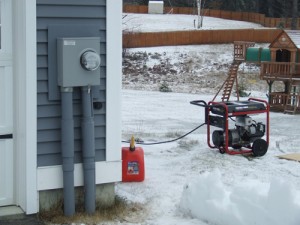Using A Backup Generator
Backup Generator – When the Lights Go Out


Hurricane Irene is breathing down our neck here in NH today. As the storm approaches I thought it was a good time to revise an older post here and mention backup generators.
It’s a really good idea to be prepared with a backup generator for power outages. We have a small portable Porter-Cable Generator that I purchased during an awful ice storm several years ago and had it hooked up to our main electrical panel. I wanted to point out a few things you should consider when using backup generators.
Generator Safety
Using a backup generator can help keep your family safe from weather elements. However, improper use of a backup generator can lead to serious injury or even death. By following a few simple guidelines you can safely use your generator.
- Keep generators at least 10 feet away from your home. It’s especially important to keep them out of your house or garage to prevent carbon monoxide poisoning.
- Never fill your generator with fuel while it’s running or hot.
- Never “backfeed” your house with a generator. “Backfeeding” is the practice of connecting your generator directly to your electric panel without the use of a transfer switch. Typically people do this by connecting the generator to the dryer outlet or directly to the electrical panel. This is a serious code violation and a serious health risk to utility workers.
- Use the proper size wire gauge to connect the generator to your transfer switch.
- Contact a licensed electrician to help you properly connect your generator to your home.
Generator Operating Tips
It’s really important to follow the manufacturers recommendations on proper operation of your generator. Be sure to follow some simple steps to ensure your generator runs properly.
- Check the oil every 8 hours of operation. It seems that most small engines typically burn some oil and it’s important to keep the oil level full.
- Let your generator take a break. Most generator manufacturers recommend letting your generator cool down on a regular basis. Let the generator burn a full load of fuel, then let the generator cool down for an hour. Fill it with fuel and start it up and let it run again until it runs out of fuel.
- Be sure to use clean fuel.
- If the weather is wet try putting a beach umbrella over the generator to keep rain and snow off the unit, but never place the generator inside a garage or house.
Hopefully we’ll only have another day or so waiting for the utility line crews to reach our area and repair the damage.
Recent Posts
Framing Stick Nailer vs Coil Nailer
Which is Better a Stick Nailer or Coil Nailer? Framers have many choices in nailers…
How Many Roofing Nails Per Square of Shingles
Estimating How Many Nails for a New Roof When it comes to estimating materials for…
Composite / PVC Decking – Layout Tips & Advice
Composite / PVC Decking Layout Tips and Advice Composite and PVC decking have really changed…
Benefits of an ERV System (Energy Recovery Ventilator)
Benefits of ERV Systems (Energy Recovery Ventilator) If you're building a new home or doing…
Vermiculite Attic Insulation Abatement
Vermiculite Attic Insulation If your home was built before 1990 there is a chance it…
Nuisance Tripping of AFCI (Arc Fault) Circuit Breakers
Arc Fault (AFCI) Circuit Breakers Tripping Often An arc-fault circuit interrupter (AFCI) or arc-fault detection…

View Comments
Great advise on the safety tips. I would just like to stress the importance of using a generator as you stated and to never even think about using one indoors.
I live in Louisiana and purchased a generator after Hurricane Katrina and it was put to go use this year during Hurricane Gustav.
Sadly, many people die every year from not using their generators properly and following your safety tips.
Thanks for the good advise and article.
Absolutely essential advise! Thanks for posting and hope you get power back soon.
Another key safety tip you mention, but I have seen ignored, is never adding gas to a running generator. The thinking seems to be "I'll pour carefully and won't spill". It's not spilled fuel that ignites, it's the vapors flowing down around the sides of the generator, that you cannot see nor prevent. Take a look at your generator running at night some time. You will likely see some small flame bursts or embers come from the exhaust at times. Combine that with gas fumes and you have a recipe for disaster.
And thanks for the beach umbrella idea. We got through Irene unscathed, but if I had to, I was wondering how I would refuel in the pouring rain without getting too much water in the fuel tank.
You are correct. I did list the fueling while running issue in the article but it's worth pointing out again. Shutting down for 1 minute is the only safe way to approach it.